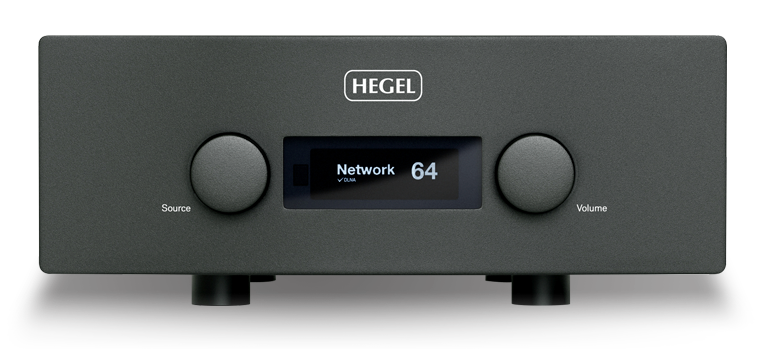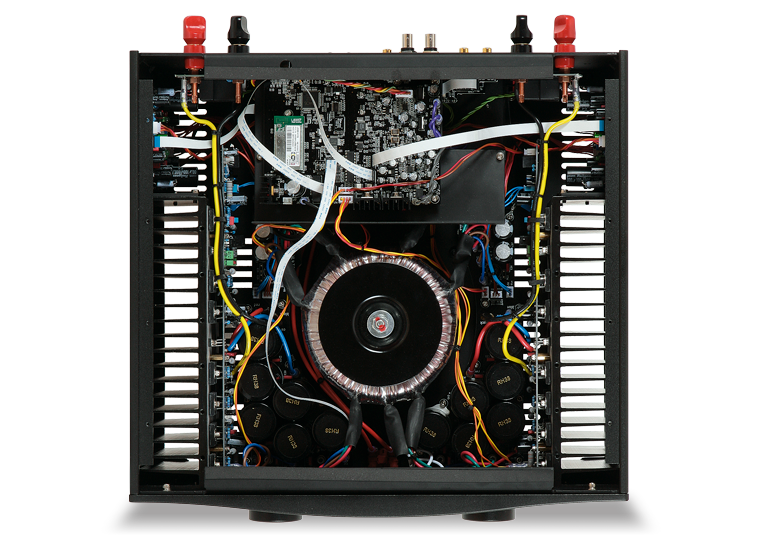 Hegel Music Systems’ new H590 is, by far, their most costly integrated amplifier-DAC to date, at $11,000 USD. Their next-most-expensive model is their previous flagship integrated-DAC, the H360, at little more than half that price: $6000. But at 17”W x 6.8”H x 17.6”D and almost 50 pounds, and specified to deliver at least 301Wpc into 8 ohms, the H590 is larger, heavier, better built, more powerful, and has more features. And according to Hans Wetzel’s review of the H590 on this site last month, it sounds better. Hans attributed much of that improvement to the H590’s “magnificent D/A converter,” and he should know -- he owned an H360 at the time of review, and before that he’d owned the H360’s predecessor, the H300.
Hegel Music Systems’ new H590 is, by far, their most costly integrated amplifier-DAC to date, at $11,000 USD. Their next-most-expensive model is their previous flagship integrated-DAC, the H360, at little more than half that price: $6000. But at 17”W x 6.8”H x 17.6”D and almost 50 pounds, and specified to deliver at least 301Wpc into 8 ohms, the H590 is larger, heavier, better built, more powerful, and has more features. And according to Hans Wetzel’s review of the H590 on this site last month, it sounds better. Hans attributed much of that improvement to the H590’s “magnificent D/A converter,” and he should know -- he owned an H360 at the time of review, and before that he’d owned the H360’s predecessor, the H300.
Hans’s review emphasizes that the H590 includes “Hegel’s first entirely new DAC design since 2010.” It uses an Asahi Kasei Microdevices (AKM) 4493 DAC chipset and has eight digital inputs, seven of them able to accept PCM signals up to 24-bit/192kHz (its support of Apple AirPlay is limited to 16/48, an inherent restriction of that technology). The H590’s USB input is even more capable, supporting PCM up to 32/384 and DSD 64/128/256. It’s also the first Hegel product to natively decode and render MQA -- and it does that through its own internal digital pathway, so as not to negatively affect DSD and PCM playback. Control4 compatibility and two-way IP control, for integration with home-automation systems, are standard. For full network integration and music streaming, Hegel has designed their own operating system for the H590 and their other integrateds that relies less on a wealth of features -- it can be used with third-party apps such as Bubble UPnP -- than on speed, for user-responsiveness.

Per Hans, “The [H590’s] dual-mono amplifier has independent gain stages and power supplies for each channel, has 12 transistors per channel to the H360’s eight, and has a toroidal power supply that’s 50% bigger than the H360’s.” The H590 also includes the latest iteration of Hegel’s SoundEngine technology, SoundEngine2, which Hans described as a “system of feed-forward error correction [that] effectively eliminates the crossover distortion inherent to class-AB amplifier designs, and has been used to great effect in each of Hegel’s current integrated-DACs.” Hegel also claims that the H590’s power-supply section is greatly improved over their previous designs. And for analog inputs there are “two pairs balanced (XLR) and three pairs unbalanced (RCA), one of the latter configurable as a home-theater input, as well as separate fixed and variable outputs (RCA).”
Hans used the H590 with lots of different loudspeakers: KEF LS50 and R700, Q Acoustics 3050i, Scansonic M-40, and Technics SB-G90. With that varied range of bookshelf and floorstanding models he determined that, compared to Hegel’s H300 and H360, “[t]he H590 trod new territory” sonically: “Its sound had a genuinely lifelike quality that places it in the company of some of the finest amplifiers I’ve ever heard. It provided an unusual combination of transparency and liquidity that I haven’t heard outside of one of Devialet’s Expert amplifiers.”

In his review of the H590 Hans also praised the H360 and H300, particularly for their “clean,” “crystalline” sound -- but noted that those sounds also had a “slight mechanical quality.” About the H590, he declared: “I could never finger any identifying characteristic or idiosyncrasy that stood out from the sound of the rest of the signal chain. Thinking I’d at last heard a distinct sonic signature, I’d swap out one pair of speakers for another -- only to hear that signature disappear. I swapped out speakers a lot.”
As a result, when Hans played Haerts’s “Hemiplegia,” from Haerts (16/44.1 ALAC, Columbia), he found that “the Hegel exercised supreme control over lead singer Nini Fabi’s wispy voice. Her sibilants were delicate yet precise, and the H590’s ability to cast a huge soundstage was readily displayed. Most noteworthy was how dynamic the amp sounded. Fabi sounded vibrant and eager, seemingly unshackled from the rectilinear KEF LS50s from which she was being propelled. There was no edginess or hash to the sound of her voice, and none of the forwardness I’ve heard from past Hegel amps -- just uncompromised control and articulation.”
Our measurements of the H590, performed by Bascom H. King of BHK Labs, revealed a power output of 322.7W into 8 ohms (<1% THD) -- no wonder Hans found the Hegel easily able to drive every pair of speakers he drove with it. But sheer power output was not all the H590 excelled at. After playing “The Battle,” from Hans Zimmer’s score for the film Gladiator (16/44.1 ALAC, Decca), Hans wrote: “This track, arguably the most challenging in my entire collection, was a feast for the ears as the Hegel exerted exemplary control over the thunderous bass lines in the first 90 seconds. Only one other amp I’ve heard matches the Hegel’s bass control below 80Hz -- Devialet’s Expert 130 Pro -- but the H590 offers more than three times as much power; it really is a howitzer.”

Listening to “What’s the Difference?,” from Dr. Dre’s 2001 (16/44.1 FLAC, Aftermath/Tidal), Hans “was impressed with how composed the Hegel was, especially as the volume scaled up; the sound never turned harsh. . . . Some amps have powerful, robust bass that’s more the result of bass volume than bass quality. Few possess the iron-fisted control needed for proper slam, that concussive quality that yields bass so tight it almost transcends a listening room’s bass modes and poor acoustics to hammer low-frequency energy right into my chest -- but the H590 was one of them.”
Hans explained that, ever since the H590 was launched last May, at High End 2018, in Munich, he’d been wondering if Hegel could make the transition from a $6000 to an $11,000 integrated-DAC and still retain the reputation for value they’d built up over the years -- or had they, in his words, “lost the plot”? His Conclusion makes it clear that they haven’t lost track of their values: “the H590 delivers, and then some. Its massive power output makes it an unflappable partner for just about any loudspeaker, past or present, and it has a wealth of digital and analog inputs, including BNC and dual XLR. But most impressive is its magnificent D/A converter. Through its USB input, I enjoyed some of the finest reproduction of music ever to grace my listening room.”
The H590 is Hegel Music Systems’ most expensive integrated-DAC ever. In every way, it’s also their best, with sound quality that makes it a natural addition to our list of Recommended Reference Components.
Manufacturer contact information:
Hegel Music Systems AS
PO Box 2, Torshov
NO-0412 Oslo
Norway
Phone: +47 22-60-56-60
Fax: +47 22-69-91-56
E-mail: info@hegel.com
Website: www.hegel.com






















